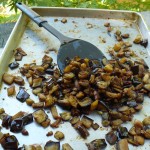 One of the biggest reasons people do not follow a Real Food diet is because they falsely believe that it is out of their budget to do so. A few quick searches on the internet for grass-fed meat and raw dairy yield prices that can sometimes be four times as much as their conventional counterparts. Defeated, the patron shrugs and goes back to their “affordable” eating habits.
One of the biggest reasons people do not follow a Real Food diet is because they falsely believe that it is out of their budget to do so. A few quick searches on the internet for grass-fed meat and raw dairy yield prices that can sometimes be four times as much as their conventional counterparts. Defeated, the patron shrugs and goes back to their “affordable” eating habits.
Do not be discouraged! Real traditional foods do not have to break your budget. There are many money saving strategies that you can follow in order to be able to afford Real Food. These money saving tips and tricks may not be noticeable at first, but over time you will see a considerable savings.
Money Saving Tips for a Real Food Diet
- Participate in a Farmshare or CSA (Community Supported Agriculture). Many CSA’s and Farmshares offer locally-grown, organic produce at a fraction of what you would pay at the store. CSA’s are not just for the country! There are plenty of CSA’s operating in cities. Some CSA’s and Farmshares are also an excellent source for grass-fed meat and dairy.
- Join a natural food co-op. Co-ops offer significant price drops on packaged foods, grains, herbs, dairy, produce, meat and more. Some examples are Azure Standard, UNFI, Beyond Organics and Green Polka Dot Box. With co-ops you don’t always have to buy in bulk and can just purchase what you want.
- Plant a garden. Yes, it may be a bit of work, but it’s also an excellent opportunity to gain an appreciation for where your produce comes from and connect with nature while getting your dose of vitamin D.
- Buy meat by the side. Half of a grass-fed beef will yield about 200 lbs. of meat, organs, tallow and bones. The meat is sold by the pound no matter what the cut. Purchase a used chest freezer and store your half a beef, lamb or buffalo in it. This will also give you the opportunity to taste and learn how to cook other cuts of meat you wouldn’t normally purchase.
- Eat organ meat. Not only are organ meats (liver, heart, kidney, sweetbreads and tongue) nutrient dense, but they are very inexpensive. If you can’t afford other grass-fed meat, opt for grass-fed organ meat to get the most nutrients for your buck.
- Purchase cheap cuts. If you can’t purchase by the side, look for meats that are cheapest like shanks, hocks, oxtails and shoulders. Not only will you get some great meat, but you will be able to use the bones to make a nice mineral rich bone broth.
- Use those bones. Bones can be used to create nutrient and mineral rich bone broths and stocks which are excellent for healing the gut and treating illnesses. Not to mention they make the best tasting soups, stews and sauces.
- Buy in bulk. Purchase some food grade plastic buckets and gamma lids to store your grains and legumes in. Purchasing dry goods 50 lbs at a time yields a significant price decrease. Other items like supplements, herbs and oils can be purchased when on sale in bulk and stored in a cool pantry. Purchase large amounts of produce in season and preserve it by freezing, dehydrating or lacto-fermenting.
- Get rid of unnecessary things. Do you need two cars that you’re still making payments on? Get rid of the cable. Downsize your home. Do what it takes to give yourself more room in your grocery budget. Spend less elsewhere. All the fringe in life doesn’t mean much if you don’t have good health. Invest in your health by eating good food and live a longer, healthier life. Find out what is sucking up your budget and fix it. Often the largest culprits are entertainment, beauty/toiletries and clothing. Stop eating out (it’s difficult to find quality food out anyway); limit your purely entertainment outings; consider making your own soaps, toothpaste, shampoo and deodorant (it’s actually quite easy) and cut down your wardrobe.
- Make friends with the local farmers and butchers. Often they will let you in on great deals or even give you parts that their other customers don’t want. This can mean lard, tallow, bones and organ meats for free or reduced.
- Go to the farmer’s market at the end of the day. Farmers often reduce their prices at the end of the day so they have less to pack up and lug back to the farm. Also, items that have already been picked will not last long, so farmers are eager to get rid of produce at the end of the day.
- Make a budget and stick to it. Time-tested and true method for saving money. There are plenty of free online tools to help you do this.
- Make as much as you can from scratch. Items like bottled dressings, condiments and snacks are not only difficult to find without additives, but are a serious drain on the budget. Make you own for a fraction of the cost and also maintain a higher level of nutrition.
- Eat more starchy vegetables. Starchy vegetables like peas, carrots, sweet potatoes, squash and beets are significantly less expensive than meat and will give you a carbohydrate boost
- Eat less. It’s true, most of us eat far more than we ought. Part of this is caused by our poor diets. When you eat a Real Food diet, you will notice that you will have less cravings and will feel more satisfied, therefore you will likely eat less automatically.
- Keep chickens or purchase and eat a lot of eggs. Eggs are one of the most perfect foods, rich in protein and saturated fat. Even the eggs from pasture-raised hens are usually less than grass-fed meat. Eggs are great for any meal and are a handy, portable snack.
- Pick your own produce. Look for local areas where you can pick wild berries, nuts and vegetables. They are free! Take advantage of U-pick farms where you get a discount rate on the produce for doing the labor.
- Render your own fat. Coconut oil is affordable if you wait for a sale and buy in bulk 5 gallons (yes, you will use it all). Get fresh leaf fat and kidney fat from local farmers and butchers (often free or really cheap) and render it yourself for a fraction of the cost of prepared.
- Consider what you are already saving. Just by going on a real food diet, you will no longer be purchasing expensive prepared snacks, pre-packaged meals, soft drinks an many other unhealthy items. Plus, you will save money on medical bills in the long run.
- Go fishing or hunting. Really get close to your food. Hunting and fishing can be a relaxing outing away from crazy life and also provide pure foods for your family to enjoy.
- Plan ahead. Make a meal plan each week so that nothing goes to waste. Consider what you have on hand already and only purchase a few new items each week, unless something is on sale that you can purchase in bulk and preserve. Consider what is in season when making your meal plan.
- Don’t always buy organic produce. Sometimes organic produce is comparable, sometimes less, but often it can be a lot more than conventional produce. If price is a factor, consider the dirty 15 and clean 15 list put out by the EWG and only purchase organic if they are on the dirty 15 list.













